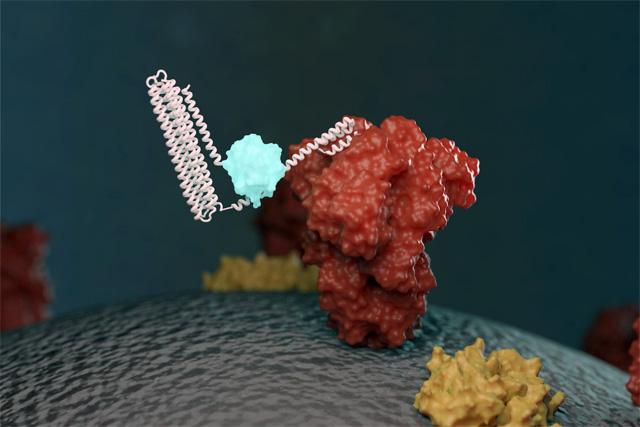
The development of CRISPR has been a huge game changing technology. The emergence of Protein Switches could also be in the same league.
Published in Nature is the draft of a paper titled “De novo design of modular and tunable protein biosensors“. It still needs to go though proof reading and typesetting. Nature however have made the decision to publish this early draft as soon as possible.
The Abstract
The full text of the abstract is as follows ..
Naturally occurring protein switches have been repurposed for developing novel biosensors and reporters for cellular and clinical applications1, but the number of such switches is limited, and engineering them is often challenging as each is different. Here, we show that a very general class of protein-based biosensors can be created by inverting the flow of information through de novo designed protein switches in which binding of a peptide key triggers biological outputs of interest2. The designed sensors are modular molecular devices with a closed dark state and an open luminescent state; binding of the analyte of interest drives switching from the closed to the open state. Because the sensor is based purely on thermodynamic coupling of analyte binding to sensor activation, only one target binding domain is required, which simplifies sensor design and allows direct readout in solution. We demonstrate the modularity of this platform by creating biosensors that, with little optimization, sensitively detect the anti-apoptosis protein Bcl-2, the IgG1 Fc domain, the Her2 receptor, and Botulinum neurotoxin B, as well as biosensors for cardiac Troponin I and an anti-Hepatitis B virus (HBV) antibody that achieve the sub-nanomolar sensitivity necessary to detect clinically relevant concentrations of these molecules. Given the current need for diagnostic tools for tracking COVID-193, we used the approach to design sensors of antibodies against SARS-CoV-2 protein epitopes and of the receptor-binding domain (RBD) of the SARS-CoV-2 Spike protein. The latter, which incorporates a de novo designed RBD binder4, has a limit of detection of 15 pM and a signal over background of over 50-fold. The modularity and sensitivity of the platform should enable the rapid construction of sensors for a wide range of analytes and highlights the power of de novo protein design to create multi-state protein systems with new and useful functions.
For some the big headline here is that they have developed a way to detect COVID-19 using protein switches.
This is highly significant, not because it involves COVID-19 detection, but rather because of the emergence of this new technology itself.
The Press Release
The actual press release on this (see here) plays the COVID-19 card…
Scientists have created a new way to detect the proteins that make up the pandemic coronavirus, as well as antibodies against it. They designed protein-based biosensors that glow when mixed with components of the virus or specific COVID-19 antibodies. This breakthrough could enable faster and more widespread testing in the near future. The research appears in Nature.
It then proceeds to expand upon how hard and costly testing for COVID-19 is and that this makes all that a lot easier. COVID … COVID … COVID … and how this makes detection a lot easier …
“We have shown in the lab that these new sensors can readily detect virus proteins or antibodies in simulated nasal fluid or donated serum, said Baker. “Our next goal is to ensure they can be used reliably in a diagnostic setting. This work illustrates the power of de novo protein design to create molecular devices from scratch with new and useful functions.”
The real significance, the truly game changer here, is not COVID detection at all.
There now exists a new very powerful tool within the bio-technology toolbox.
Well yes, we have had protein switches since 2019. That was when scientists reported the design and creation of the first completely artificial protein switch. That went almost unnoticed. But as Steve Novella points out …
but looking back this may have been as momentous as the development of CRISPR as a tool for genetic engineering. It’s hard to tell how much of a long term impact it will have – but just as CRISPR (and related tools of genetic engineering) gives us unprecedented control over a fundamental aspect of biology (genetics), protein switches also potentially give us a similar level of control, arguably more direct.
What exactly is a Protein Switch?
A protein has a three dimensional structure. A protein switch is a protein that will change this configuration when it binds with something else. If you change its configuration then you also change what it does.
What this new Nature study reports is that they have created a protein switch that operates as follows
- If it binds with the COVID-19 protein then it will alter its configuration and glow with bioluminescence
- If there is no COVID-19 protein, then it retains its off state and does not glow
Yes, lots more testing will be needed, but hit pause and park COVID-19 for a moment.
There now exists a way to create a protein switch that can be used to potentially detect anything of interest very easily. This is of course why they used the term “biosensors“, because this is exactly what this is.
Translation: Medical diagnostics has just made a huge leap forward.
The real significance
The really big deal here is not this specific COVID-19 application of a protein switch, but the modular design of what they have done to achieve that. This is a reusable tool that has many different applications …
Beyond COVID-19, the team also showed that similar biosensors could be designed to detect medically relevant human proteins such as Her2 (a biomarker and therapy target for some forms of breast cancer) and Bcl-2 (which has clinical significance in lymphoma and some other cancers), as well as a bacterial toxin and antibodies that target hepatitis B virus.
